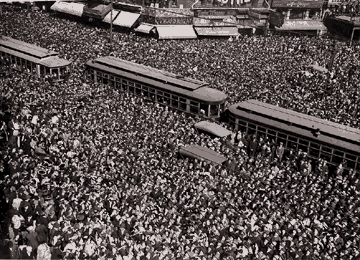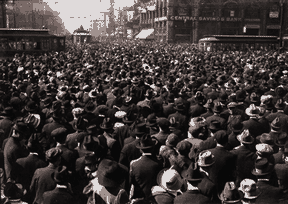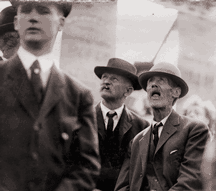The Human Fly (Henry H. Gardiner)
By Vivian M. Baulch
On Oct. 7, 1916, a lunchtime crowd of 150,000 gathered at Woodward and Michigan avenues, spilling into Cadillac Square. At the time, it was the largest crowd ever assembled in downtown Detroit.
They had come to see the man dubbed "The Human Fly" by President Grover Cleveland. Harry H. Gardiner, a slight man with powerful hands and feet, was in town to climb the Majestic Building at 137 Woodward.

The Detroit News, soon to move into its new building at 615 W. Lafayette, had hired the nationally known Gardiner to attract attention to the News' ad-taking office in the Majestic Building. It was promoted as more convenient for the advertiser and more efficient for the newspaper. "Want ads" dropped off at that office were transmitted "by private phone wires" and got into type more quickly than those taken to the main office at 63 Shelby.

The stunt, set for 12:15 p.m., aimed at the business lunch crowd. "You watch him tomorrow," a Detroit News story trumpeted. "He will come from the door of The News downtown office dressed in a white duck suit and hat, with a Detroit News bag thrown over his shoulder and several copies of the latest edition in it. He will walk to the base of the great pillar to the left of the Central Savings Bank entrance. Standing there for a second, the preliminaries over, you will see him cross himself. From that moment Gardiner will not speak a word until he has reached his goal. It is his way of giving himself into the care of his Creator before he ventures forth on his walk between heaven and earth."
The News promo was dramatic, the event more so. The crowd gathered before noon. All traffic stopped. The police vainly tried to keep a path open at least for the street cars.
Gardiner reportedly was not nervous, but smiled confidently as he began his climb.
Up, up, up went the figure in white. He wore white tennis shoes on his feet and rimless spectacles on his face. The sea of faces stared silently. "They dared not cheer," said the News account. "Men stood and stared with bulging eyes. Women hugged their babies to their breasts and held their breath."
The crowd gasped as he let go of all but one hand and hung there. He swung himself back and forth in a pendulum motion until he had thrown himself safely onto the next ledge.
Hand over hand, his fingers finding crevices and holds between bricks and great blocks, he climbed toward the roof. An intense moment occurred when, as Gardiner hung onto the face of the building with one hand, he reached sideways and upwards with the other. A piece of stone broke off. The crowd gasped. Gardiner carefully picked it up and handed it to his manager, who was looking out of a nearby window.
At the eighth floor, a man in a window stretched out his hand from above in an apparent effort to entice the climber to safety inside. Gardiner declined.

The biggest sensation came when he approached the 12th story, where the windows were surmounted by great stone arches.
Only one window, at the corner of the building, had no arch. To reach it, Garinder had to pass around the bulging support of the nearest arch.
Three times he tried and failed.
On a fourth try, he straddled the pillarlike obstruction, got a heelhold on a solid ledge, and edged his body downward to where he could grip the window ledge with his hands.
"He gripped it, then let go with his heels," The News reported. "His body dangled between heaven and earth. (He) swung back and forth like a pendulum. Once, twice, three times, with ever-quickening sweeps. Then suddenly the heels shot out, reached up to the windowsill and rested there, the hands moving away until the body was almost straight.
"In that vast crowd, it almost seemed that if a pin dropped it would have sounded like an explosion. Only when he reached the rope waiting for him to be pulled safely over the jutting edge of the top of the building did the really big cheer break. And then it broke in wave after wave."

Gardiner waved at the cheering crowd from the pinnacle. The 211-foot climb had taken 37 minutes.
The event was so popular that a repeat performance was scheduled a few days later. Gardiner practiced by climbing the old Pontchartrain Hotel to promote the Gordon-Pagel bakers. However, the crowd and the disruption of the first climb was so great that the second Majestic event was canceled.
The paper announced: "The News bows cheerfully to the best interests of the city as a whole and has cancelled the intended climb for next Saturday night."
History of the Majestic Building
In the late 19th century, Detroit department store mogul C.R. Mabley began to build a combination retail and office building that would be the tallest in Detroit -- 14 stories -- and grandly appointed.
The site at Woodward and Michigan had cost $700,000 and the construction $1 million. But financial difficulties had beset the builder and by the time the Mabley Building was to open in 1896, Mabley was no longer the owner. A new building syndicate was organized to finish the structure.
The trouble was, Mabley had ordered the architects to put the initial "M" in every capstone and on everything else he could think of, including each brass knob of the hundreds of office doors.
The problem of the building's name was solved by Edward H. Doyle, a leader of the new syndicate.
"The letter is M," Doyle said, "and we will call the building what it is -- Majestic." The Majestic was an awe-inspiring attraction in its early years. Families from miles around would hitch up their buggies and drive downtown to take the elevator that whisked them to the 14th floor. There they could pay a dime and climb a flight of stairs to a roof observatory. As advertised, they found "an unobstructed view for 12 miles."
"It cost a lot a money for a look," said a 1961 Detroit News account by an old-timer. "A dime when you could get a big Sunday dinner featuring fried chicken for 20 cents ... but, by golly it was worth it.
"For the Majestic Building was the center of darned near everything in the fastest-growing city in America.
"Here was the meeting place of everyone, but particularly of young sweethearts who used to saunter down to the dance pavilion ablaze with genuine incandescent lights at the foot of Wayne.
"It was a science center, too. Back before the days of airport weather stations -- from 1907 until the end of 1933 -- roof visitors could see the United States Weather Bureau experts making their mysterious atmosphere observations."
The Majestic lost its position as top among Detroit skyscrapers in 1908, when the 19-story Ford Building was completed, but it remained the symbolic center of downtown. It met the wrecking ball in 1962, and was replaced on the site by the First Federal Building, which opened in 1965.
Fly specs
- The Guinness Book of World Records gives the longest vertical climb on the face of a building as the one by Daniel Goodwin of California. On May 25, 1981, he wore a Spiderman costume as he climbed a record 1,454 feet up the Sears Tower of Chicago, using suction cups and metal clips for support.
- H.F. Young, another "human fly," died March 5, 1923, in a nine-story fall from the front of the Hotel Martinique in New York. Two others died in stunts in 1924. Many cities subsequently enacted ordinances prohibiting the scaling of buildings.
- In 1981 Canadian aerialist Jay Cochran planned a tightrope walk between two of the Renaissance Center towers, but he was stopped.
- In 1983 Rick and Ron Broyers were arrested for trespassing when they climbed to the top of the Westin Hotel in the RenCen.
- In 1988 four Greenpeace members were arrested climbing the RenCen. They wanted to hang banners to protest the Detroit incinerator project as a cause of air pollution.
Researchers: Vivian Baulch, Linda Culpepper, Kay Houston, Anita Mack, Laurie Marzejka, Julie Morris, Jenny Nolan, Pat Zacharias, Wendy Culpepper
Editorial and production: Ray Jeskey, Larry Wright, Alex Vida
